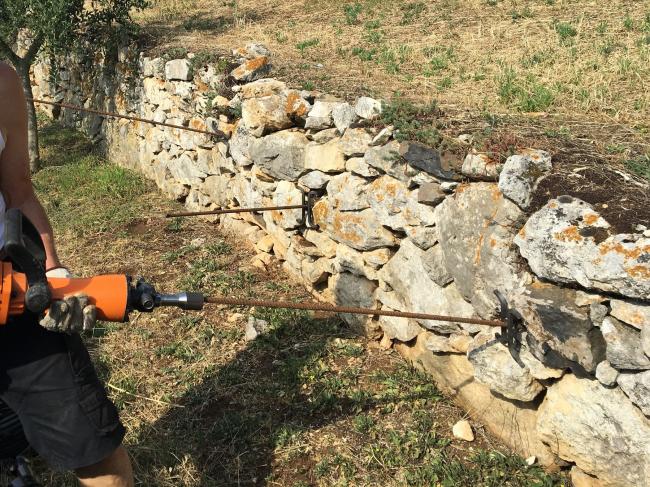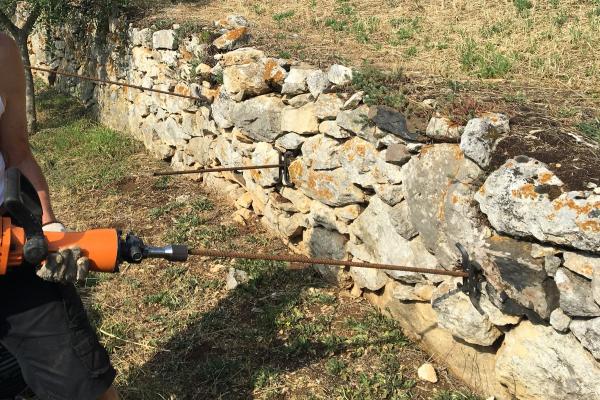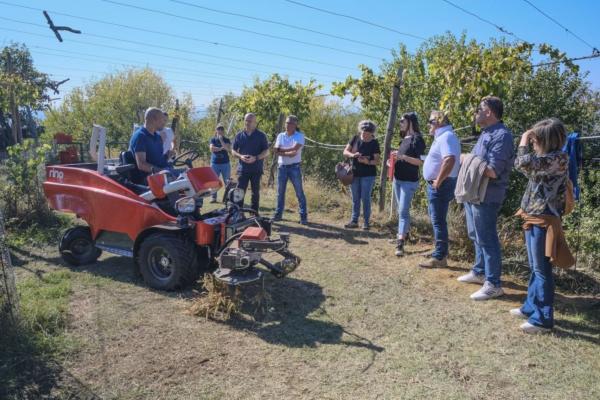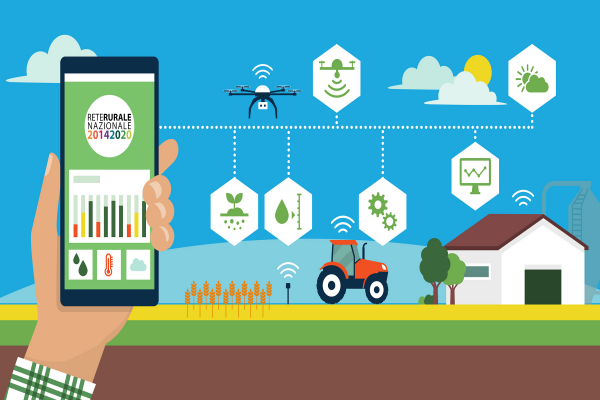Innovative solutions for soil erosion risk mitigation and a better management of vineyards in hills and mountain landscapes.

Principal results will be:
• enhancement of environmental sustainability of vineyards agroecosystems in hilly and mountain landscapes, with special focus on the reduction of soil erosion risk;
• minimization of the impact of cultivation practices, by the development of innovative technical solutions and tractors which will reduce soil load and compaction;
• introduction of conservation techniques - sustainable and low-cost - for traditional artifacts aimed at reducing soil erosion;
• development of an integrated management approach to combine production targets of farmers with preservation of environment and landscape.
SOiLUTION SYSTEM aims at developing an integrated system of technologies and management approaches, environmentally and economically sustainable, to reduce soil erosion and improve soil in steep-slope vineyards where hydro-geological risk is high.
Innovative tools for topographical survey will be used, along with new instruments to monitor precipitation erosivity. Newly-designed, low-impact tractors will be developed to cultivate steep-slope vineyards, and innovative technologies to manage and consolidate terraced vineyards. Overall sustainability of the approach will be evaluated and improved.
Cultivating in hilly and mountainous areas and maintaining terraces, where present, requires a considerable use in terms of economic (and human) resources compared to the plain. Even high-quality vineyards cultivated in the most popular areas of the territory, very economically competitive and well maintained, can be affected by more or less obvious hydrogeological failure phenomena, with possible repercussions also on the urbanized areas of the plain. The reasons for this criticality are different: the geomorphological conformation, the climate change in place and the technique of growing the vine and/or management of the terraced area. Italy is a particularly complex territory from a geomorphological point of view, for centuries affected by landslides and floods. To this intrinsic fragility is added, today, the pressure of climate change with extreme weather events: rainfall, compared to the past, is more intense, short-lived and localized.
The SOiLUTION SYSTEM project aims to develop an integrated system of environmentally and economically sustainable interventions and technologies, with the aim of solving the problems described above, reducing the risk of erosion and, in general, failure, ensuring better soil management in areas of high hydro-geological risk, maintaining the landscape value of hill and mountain vineyards and the productivity of them. The approach adopted is multidisciplinary and system (as a territory) and involves the main categories of strategic actors operating in the area and directly interested and involved in the application of the proposed innovations.
WP1 - Digital terrain analysis
Within "WP1 - Digital terrain analysis", following a preliminary recognition of the study areas, topographic surveys have been carried out with the innovative Structure-from-Motion (SfM) photogrammetric technique and using a low cost commercial Unmanned Aerial Vehicles (drone). It allows the high-resolution three-dimensional reconstruction of the surveyed area and allows to perform a series of geomorphological and hydrological analyses useful to understand the areas most susceptible to the erosion phenomena (such as, for example, identifying the areas of accumulation of surface runoff). Through the appropriate algorithms application, thematic maps are then elaborated, easy to read (using intuitive chromatic scales) and to identify the most problematic sites. Thanks to this methodology it is therefore possible to offer to the end users (farmers, consortia, farms, etc.) a powerful tool for knowledge of the territory at low cost and, also, a clear location of potentially unstable areas that need to be careful monitored. These tools can also be used for the design of runoff regimentation interventions, such as the drainage network, with the aim of reducing the surface instability risk.
WP2 - Monitoring of erosive processes and setting up warning systems
Within "WP2 - Monitoring of erosive processes and setting up warning systems" it is expected to obtain a field validation of the simulated results through the outputs obtained in "WP1 - Digital terrain analysis". In particular, based on the surface runoff map and the RPII (Relative Path Impact Index) map, a series of stakes are installed inside the vineyard in areas where high runoff concentration and/or high RPII values are expected. In this way, during particularly intense rainfall events, a field survey is carried out (and will be carried out in the next few months) to observe whether there is an accumulation of runoff in the proximity of the stakes.
This methodology aims to prove the effectiveness of the technique of identifying potentially unstable areas proposed in SOiLUTION SYSTEM (and therefore susceptible to the phenomenon of erosion, which can cause landslides and instabilities), so as to provide stakeholders with a low-cost, cognitive tool for the processes and dynamics that take place within the steeply sloping vineyard, useful for the definition of hydraulic arrangement interventions, with particular attention to the maintenance of the terraces system and historical dry stone walls.
WP3 - Sustainable mechanization.
The innovation involves the development of a prototype for low environmental impact processing in steeply sloping vineyards, to be used in the following activities:
• creation of prototypes of accessory equipment for the processing of the sub-row in conditions of steep slope, combined with innovative electric motor systems with low environmental impact;
• field tests in partner companies and assessment of the effectiveness and efficiency of the prototypes of equipment combined with innovative and sustainable systems of electric traction;
• comparison of the performances of the prototypes with those of conventional sub-row management equipment.
The main outputs / expected results are:
• innovative prototypes of sub-row management equipment, equipped with electric traction systems, adapted for use in hill and mountain areas with steep slopes and high risk of erosion;
• test reports performed on sites with steep slopes (on effectiveness and efficiency relating to the equipment supplied with the machines).
WP4 - New consolidation techniques for terraced areas.
The innovation involves the creation of an innovative patented system with low environmental and economic impact for the consolidation of dry stone walls and ridges, declined in the following activities:
• definition of the portions of dry stone walls and ridges where the consolidation technique will be applied;
• identification of dry stone walls with precarious stability, which have overhangs and protrusions. In relation to the ciglioni, situations have been identified which present landslides;
• implementation of the patented consolidation technique on the portions of dry stone walls and ciglioni;
• monitoring of the physical state of the consolidated dry stone wall and of the ridges.
The outputs / results of the action are:
• demonstrative consolidation of dry stone walls that show clear signs of structural failure;
• dry-stone walls and stabilized and protected shores;
• half-yearly checks to verify the status of interventions favored also by exchange meetings for the construction of knowledge.
WP5 - Conservative agriculture techniques to reduce the risk of erosion.
The innovation involves the use of conservative agronomic techniques and the selection of blends of herbaceous plants functional to the reduction of the risk of erosion and the reduction of interventions in the field, in the following activities:
• preparation of the experimental sites: 4 sites with spontaneous or spontaneous grassing; 2 sites to grass with local seed; 2 sites for green manure;
• collecting seeds on sites and sowing;
• evaluation of seedling productivity, seed conservation technique, sowing;
• introduction and evaluation of the controlled grassing technique;
• execution of the green manure and comparison between the green manure and the mowing to evaluate the state of the lawn at the end of the growing season.
On already grassed sites:
• evaluation of ground cover speed, maximum height and maximum green mass achieved with reduced management;
• biological spectrum, state and variation over time;
• feasibility assessment of management techniques with reduced number of interventions;
• assessment of the anti-erosion capacity of the grass with extreme rainfall;
• utility evaluation of the autochthonous mixtures, their management from seedling to cutting;
• assessment of the response of the grass cover to the weather and climatic conditions of the year;
• evaluation of the anti-erosion properties of mixtures of local species with extreme rains.
The expected results / expected outputs are:
• harvesting, seed conservation and sowing technique;
• evaluation of grassing speed;
• technical data sheets with agrotechnical information notes on controlled grassing techniques and on the convenience and efficacy in vineyards rich in skeleton.
WP6 - Analysis of impact on biodiversity.
Analysis of the impact of the mitigation solutions proposed in the project through a system of biodiversity indicators.
The innovation involves the realization of the following activities:
• definition of the indicators to be measured and detected;
• selection within 2 experimental sites to be monitored in parallel of the witness site (where there is already a high level of biodiversity in the agro-ecosystem) and a comparison site where the initial level of biodiversity is much lower;
• collection of the data necessary to validate or not the proposed management model;
• annual monitoring campaign in each of the two experimental sites, according to the set of biodiversity indicators identified including: the IBS-bf index, the analysis of the autochthonous floristic component, the analysis of wild apoid communities by indirect estimation and direct;
• laboratory analysis to validate the data collected in the field.
The expected results / outputs are as follows:
• creation of a set of indicators of the conservation of agro-ecosystems in the area of ??hill and mountain viticulture, useful for defining guidelines aimed at describing the best management practice, risk mitigation and biodiversity conservation;
• list of data relating to the biodiversity indicators detected, divided into 3 relevant campaigns.
Documentazione del 4° Workshop del GO SOiLUTION SYSTEM
I Gruppi Operativi, Uso del suolo, Veneto, PEI-AGRI| Titolo/Descrizione | Url | Tipologia |
|---|---|---|
|
Web Site
|
Sito web
|
|
|
News of the Project
|
Link ad altri siti che ospitano informazioni del progetto
|
|
|
Creation and upolading of the first 3D model of a vineyard
|
Link ad altri siti che ospitano informazioni del progetto
|
|
|
Slides of the project
|
Materiali utili
|
|
|
Project presentation published on EIP-AGRI web site
|
Materiali utili
|
|
|
Facebook
|
Link ad altri siti che ospitano informazioni del progetto
|
|
|
SOiLUTION SYSTEM - Project presentation
|
Materiali utili
|
|
|
SOiLUTION SYSTEM - YouTube page
|
Materiali utili
|
|
|
SOiLUTION SYSTEM: innovative solutions for soil erosion risk mitigation and better management of vineyards in hills and mountain landscapes - EGU Assembly 2020
|
Materiali utili
|


